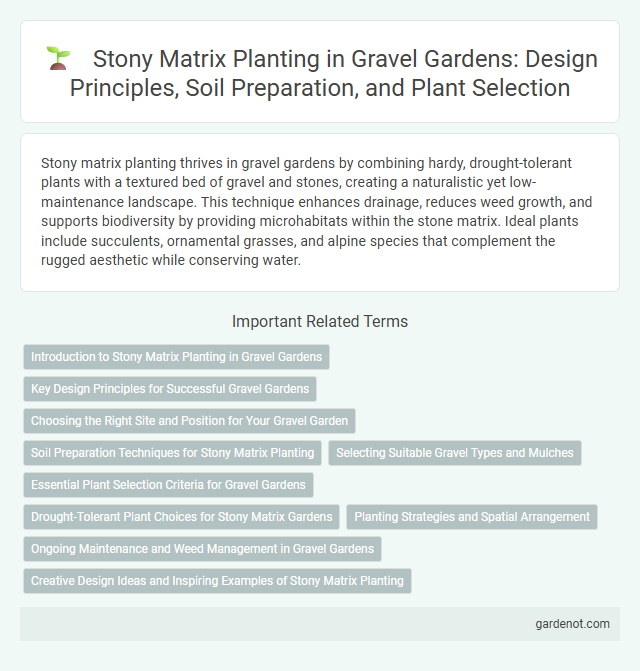Stony matrix planting thrives in gravel gardens by combining hardy, drought-tolerant plants with a textured bed of gravel and stones, creating a naturalistic yet low-maintenance landscape. This technique enhances drainage, reduces weed growth, and supports biodiversity by providing microhabitats within the stone matrix. Ideal plants include succulents, ornamental grasses, and alpine species that complement the rugged aesthetic while conserving water.
Introduction to Stony Matrix Planting in Gravel Gardens
Stony matrix planting in gravel gardens involves arranging a diverse range of drought-tolerant plants within a matrix of small stones or gravel, creating a naturalistic and low-maintenance landscape. This technique enhances drainage, reduces soil erosion, and conserves moisture while providing habitat for pollinators and beneficial insects. Common plant choices include sedums, sempervivums, and alpine herbaceous perennials, which thrive in the mineral-rich, well-drained substrate typical of stony matrices.
Key Design Principles for Successful Gravel Gardens
Stony matrix planting in gravel gardens relies on strategically combining hardy, drought-tolerant plants with well-draining, coarse gravel substrates to optimize root health and moisture retention. Emphasizing plant selection such as sedums, lavenders, and ornamental grasses enhances texture and seasonal interest while minimizing maintenance. Proper spacing and layering prevent overcrowding, promote air circulation, and create a dynamic, resilient landscape that thrives in nutrient-poor, stony environments.
Choosing the Right Site and Position for Your Gravel Garden
Choosing the right site and position for your gravel garden involves selecting an area with excellent drainage and ample sunlight, essential for stony matrix planting success. Opt for a south-facing or east-facing spot where the soil is poor or sandy, as many drought-tolerant plants thrive in these conditions. Avoid low-lying areas prone to waterlogging to prevent root rot and ensure longevity of your gravel garden ecosystem.
Soil Preparation Techniques for Stony Matrix Planting
Soil preparation for stony matrix planting in gravel gardens involves thorough soil assessment and amendment to ensure optimal drainage and nutrient retention. Incorporating organic matter like compost improves soil structure while maintaining a gritty texture that supports root aeration and moisture regulation. Proper loosening and removal of large stones create a balanced substrate conducive to the growth of drought-tolerant, low-maintenance plants suited for gravel garden environments.
Selecting Suitable Gravel Types and Mulches
Choosing the right gravel type for a stony matrix in gravel gardens depends on factors like size, color, and drainage properties, with pea gravel, crushed granite, and limestone being popular options. Mulches such as crushed stone or decomposed granite help retain moisture, prevent weed growth, and enhance soil aeration within the planting matrix. Selecting compatible gravel and mulch materials supports plant health by maintaining optimal soil temperature and moisture levels while complementing the garden's aesthetic.
Essential Plant Selection Criteria for Gravel Gardens
Choose drought-tolerant and low-maintenance plants with deep root systems for effective water absorption in stony matrix gravel gardens. Opt for species with strong anchorage abilities to withstand soil movement and erosion caused by loose gravel substrates. Prioritize plants with a natural preference for rocky, well-drained environments such as sedums, lavenders, and ornamental grasses to ensure healthy growth and long-term sustainability.
Drought-Tolerant Plant Choices for Stony Matrix Gardens
Drought-tolerant plants such as sedum, lavender, and ornamental grasses thrive in stony matrix gardens due to their deep root systems and minimal water requirements. These species stabilize gravel substrates while enhancing the garden's textured aesthetic with resilient foliage and vibrant blooms. Incorporating native xerophytes like thyme and rockrose further ensures adaptability to arid conditions and promotes sustainable, low-maintenance landscaping.
Planting Strategies and Spatial Arrangement
Stony matrix planting in gravel gardens emphasizes selecting drought-tolerant, low-maintenance perennials and grasses that thrive in well-drained, mineral-rich substrates. Spatial arrangement prioritizes clustering plants with complementary growth habits and varying heights to create visual rhythm and maximize water retention within the stony matrix. Strategic spacing ensures optimal root development and air circulation, enhancing plant health while maintaining the aesthetic of a naturalistic, textured landscape.
Ongoing Maintenance and Weed Management in Gravel Gardens
Effective ongoing maintenance in gravel gardens with stony matrix planting involves regular inspection and prompt removal of weeds to prevent root establishment in the gravel substrate. Utilizing mulch layers and selective herbicide application reduces weed seed germination while preserving plant health. Optimal drainage and minimal soil disruption also help maintain a clean, attractive gravel garden environment with reduced weed pressure.
Creative Design Ideas and Inspiring Examples of Stony Matrix Planting
Stony matrix planting transforms gravel gardens by integrating hardy succulents, alpine plants, and drought-tolerant perennials within a textured mineral base, enhancing both structure and resilience. Creative design ideas include layering contrasting stone sizes and colors to highlight plant forms, while inspiring examples showcase combinations of sedums, sempervivums, and ornamental grasses arranged to mimic natural rocky landscapes. This approach optimizes water conservation and requires minimal maintenance, making it ideal for sustainable, aesthetically striking gravel garden designs.
Stony matrix planting Infographic

 gardenot.com
gardenot.com